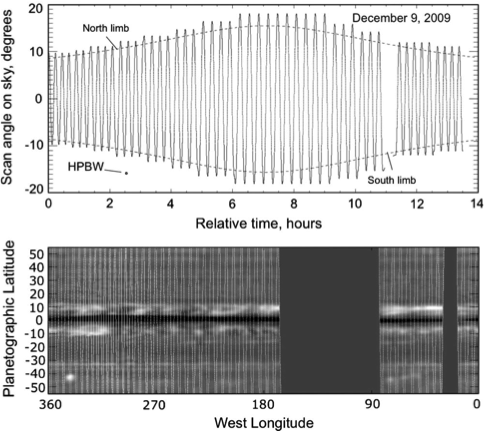
This map shows the pattern of Cassini spacecrafts well-controlled up-and-down nodding movements. These made it possible for the microwave radiometer to gather global measurements of Saturn's atmosphere, reflected in the example data
| Nominal radiometer characteristics. |
||||
|---|---|---|---|---|
| Frequency | 13.78 GHz |
| Wavelength | 2.18 cm |
| Polarization | 1 linear |
| Radiometer bandpass | 135 MHz |
| Measurement noise | 0.026 K/pHz |
| Beam full width at half-power (beam 3) | 0.36" Circular |
Cassini Radiometer Data
Derived data
This data set is comprised of well-calibrated, high-resolution global maps of Saturn’s thermal emission at 2.2-cm wavelength obtained by the Cassini RADAR radiometer through the Prime and Equinox Cassini missions, a period covering approximately six years. The absolute brightness temperature calibration of 2% achieved is more than twice better than for all previous microwave observations reported for Saturn, and the spatial resolution and sensitivity achieved each represent nearly an order of magnitude improvement. The brightness temperature of Saturn in the microwave region depends on the distribution of ammonia, which our radiative transfer modeling shows is the only significant source of absorption in Saturn’s atmosphere at 2.2-cm wavelength. At this wavelength the thermal emission comes from just below and within the ammonia cloud-forming region and yields information about atmospheric circulations and ammonia cloud-forming processes.
These maps are presented as residuals compared to a fully saturated model atmosphere in hydrostatic equilibrium. Also included are time-ordered data detailing the modeling results, referencing the midpoint of each radiometric integration period.
Observational Approach
The RADAR radiometer was used to observe Saturn during five equatorial periapsis passes occurring between 2005 and 2011 for the purpose of mapping its 2.2-cm thermal emission. Observational parameters are given below.
 Derived Data
Raw Data
Derived Data
Raw Data
The
raw data are archived by the PDS Imaging node at JPL and USGS-Flagstaff.
References
Elachi, C., et al, 2004. RADAR: The Cassini Titan radar mapper. Space Science Reviews 115, 71-110. DOI:
10.1007/s11214-004-1438-9.
Janssen, M.A., et al., 2009, Titan’s surface at 2.2-cm wavelength imaged by the Cassini RADAR radiometer: calibration and first results. Icarus, 200, 222-239, DOI:
10.1016/j.icarus.2008.10.017
Janssen, M.A., et al., 2013, Saturn’s Thermal Emission at 2.2-cm Wavelength as Imaged by the Cassini RADAR Radiometer, Icarus, Volume 226, Issue 1, p. 522-535, DOI:
10.1016/j.icarus.2013.06.008.
Moeckel, C, Janssen, M, De Pater, I, (2019) A re-analysis of the Jovian radio emission as seen by Cassini-RADAR and evidence for time variability, Icarus, 321, 994-1012, DOI:
10.1016/j.icarus.2018.12.013.
Citation
Janssen (2021) Saturn's Thermal Emission at 2.2-cm from Cassini RADAR Radiometry, NASA Planetary Data System, DOI XXXXXXXXX.
 PDS: The Planetary Atmospheres Node
PDS: The Planetary Atmospheres Node
 This map shows the pattern of Cassini spacecrafts well-controlled up-and-down nodding movements. These made it possible for the microwave radiometer to gather global measurements of Saturn's atmosphere, reflected in the example data
This map shows the pattern of Cassini spacecrafts well-controlled up-and-down nodding movements. These made it possible for the microwave radiometer to gather global measurements of Saturn's atmosphere, reflected in the example data
